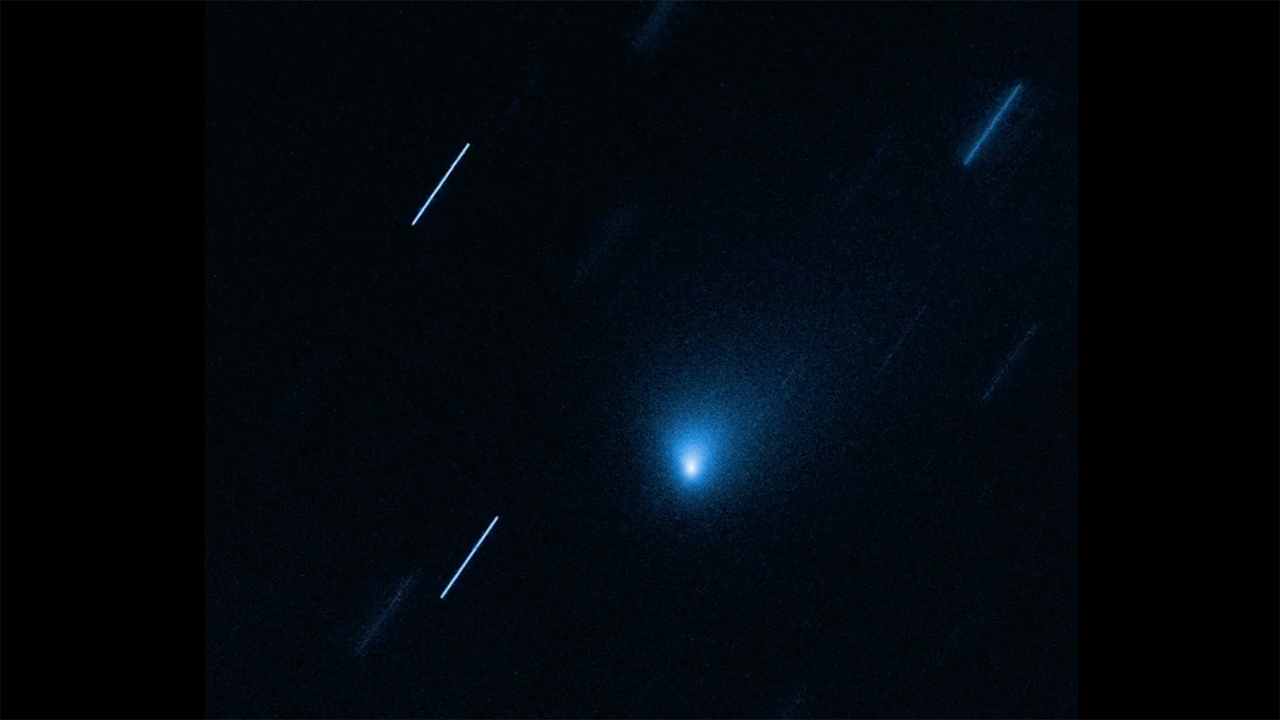1 min read
Comet 2I/Borisov

Hubble's View of Interstellar Comet 2I/Borisov
NASA's Hubble Space Telescope has given astronomers their best look yet at an interstellar visitor – comet 2I/Borisov – whose speed and trajectory indicate it has come from beyond our solar system. Hubble photographed the comet at a distance of 260 million miles from Earth. This Hubble image, taken on October 12, 2019, is the sharpest view to date of the comet. Hubble reveals a central concentration of dust around the nucleus (which is too small to be seen by Hubble). The comet is falling toward the Sun and will make its closest approach on December 7, 2019, when it will be twice as far from the Sun as Earth. The comet is following a hyperbolic path around the Sun and will exit back into interstellar space. Comet 2I/Borisov is only the second such interstellar object known to have passed through the solar system. In 2017, the first identified interstellar visitor, an object formally named 'Oumuamua, swung within 24 million miles of the Sun before racing out of the solar system.
About the Object
- DistanceDistanceThe physical distance from Earth to the astronomical object. Distances within our solar system are usually measured in Astronomical Units (AU). Distances between stars are usually measured in light-years. Interstellar distances can also be measured in parsecs.At the time of observations, the comet was 2.782 au from Earth (about 260 million miles).
About the Data
- Data DescriptionData DescriptionProposal: A description of the observations, their scientific justification, and the links to the data available in the science archive.
Science Team: The astronomers who planned the observations and analyzed the data. "PI" refers to the Principal Investigator.The HST observations include those from program 16009 (D. Jewitt) - InstrumentInstrumentThe science instrument used to produce the data.WFC3/UVIS
- Exposure DatesExposure DatesThe date(s) that the telescope made its observations and the total exposure time.12 Oct 2019
- FiltersFiltersThe camera filters that were used in the science observations.F350LP
- Object NameObject NameA name or catalog number that astronomers use to identify an astronomical object.Comet 2I/Borisov
- Object DescriptionObject DescriptionThe type of astronomical object.First interstellar comet
- Release DateOctober 16, 2019
- Science ReleaseHubble Observes First Confirmed Interstellar Comet
- Credit

These images are a composite of separate exposures acquired by the WFC3 instrument on the Hubble Space Telescope. The color results from assigning the color blue to a monochromatic (grayscale) image.

Related Images & Videos

Artist's Illustration of Comet 2I/Borisov's Orbit
Orbital Path of First Confirmed Interstellar Comet This illustration shows the path of comet 2I/Borisov through our solar system. This visitor came from interstellar space along a hyperbolic trajectory. It is only the second known intruder to zoom through our solar system. (The...

Artist's Illustration of Comet 2I/Borisov's Orbit (Annotated)
Orbital Path of First Confirmed Interstellar Comet This annotated illustration shows the path of comet 2I/Borisov through our solar system. This visitor came from interstellar space along a hyperbolic trajectory. It is only the second known intruder to zoom through our solar...

Comet 2I/Borisov Time-Lapse
This is a time-lapse sequence compressing Hubble Space Telescope observations of comet 2I/Borisov, spanning a seven-hour period. As the first confirmed interstellar comet to enter our solar system, comet 2I/Borisov is moving along at a breakneck speed of 110,000 miles per hour....
Share
Details
Claire Andreoli
NASA’s Goddard Space Flight Center
Greenbelt, Maryland
claire.andreoli@nasa.gov





























